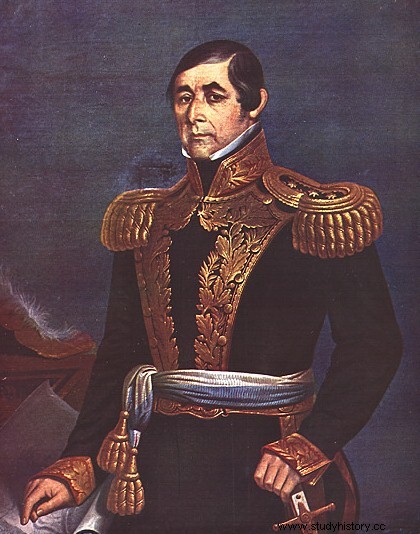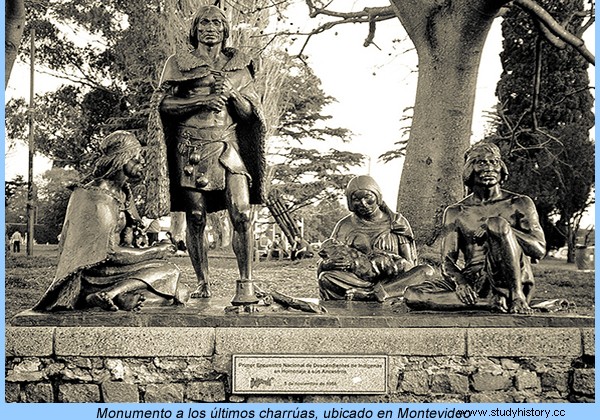Deer , the charrúa cacique, amicably extended General Rivera the knife that he had asked him to chop his tobacco. However, the military reacted unexpectedly; he jerked back, feigning surprise, and in the same motion he drew his revolver and shot her. That was the signal that the rest of his troops, some 1,200 men, were waiting to begin the attack on the little more than 400 Charrúa indigenous men, women, and children who had gathered on the banks of the stream salifyoucan . It was April 11, 1831.

Fructuoso Rivera
General Fructuoso Rivera , the first elected president of the new Eastern Republic of Uruguay, had been secretly planning this military action for some months. Driven and pressured by ranchers and landowners from the northwest of the territory, who denounced the presence of semi-nomadic groups of indigenous people in “ his of him ” fields, Rivera decided, at the beginning of 1831, to put an end to the “charrúa problem ”. And his would be a drastic and definitive solution.
– Look, Don Frutos… Your soldiers killing friends!
Shortly after the operation began, another of the Charrúa caciques named Vaimaca Pirú , he rebuked his old acquaintance, the General , due to the unexpected attack that his people were suffering.
Taking advantage of the long relationship of camaraderie and respect that he maintained with the Charrúa nation, nourished by hundreds of camps and tolderías shared during the revolutionary struggles, Rivera summoned all the Charrúa caciques to join a new military campaign that he was supposed to command against the south of Brazil, with the aim of recovering livestock and subsequently distributing it among those who participated in the expedition. Confident, the caciques responded to his call, taking with them their warriors, their women, and their children, as was their custom, well known to Rivera. In short, the entire Charrúa nation responded to the call of his old friend, Don Frutos. General Rivera, a great connoisseur of the area (baqueano ), he chose the ambush spot carefully. He took the charrúas out of the region of mountains and mountains where they had settled and summoned them to a flat place, which did not offer natural hiding places where they could take shelter. Thus, he received and entertained the Charrúas in that place with abundant food and drink, and gave the signal to attack when they were completely unprepared.
After exhausting all the resources of prudence and humanity, to attract obedience and a calm and regular life to the indomitable Charrúa tribes […] It was decided to put into execution the only means that already remained, to hold them by force […] They were consequently attacked and destroyed, leaving more than 40 enemy corpses on the field and the rest with 300 or more souls in the hands of the operations division.
That was the official statement that President Rivera sent to the president of the Senate the day after the massacre. However, the real figures were different; between the charrúas killed in the place of the ambush, those who managed to escape and were killed during the following months, and those who died after being taken prisoner during the long march of more than 400 kilometers on foot to Montevideo... more than Half of the Charrúa nation was annihilated as a result of Rivera's military action in Salsipuedes.
Only a few managed to escape and get lost in the fields, avoiding death and capture. Those who arrived in Montevideo were distributed among the inhabitants of the capital as servants, dismembering the Charrúa families according to the convenience of their new “masters ”, they quickly lost their cultural identity, their traditions and their way of life. Therefore, the final solution devised by General Fructuoso Rivera for the “charrúa problem ” was really effective. In 1833, the old cacique Vaimaca Pirú , his healer Senaqué , the warrior Tacuabé and India Guyunusa They were sold to a French businessman who shipped them to Paris to exhibit them as exotic objects. The four are known as The Last Charrúas .

For more than 150 years, the official historiography of Uruguay maintained that the Charrúa ethnic group had become completely extinct. However, in the 1990s, historical and genetic studies began to be carried out, which confirmed that a large number of people, especially in the North and Northeast areas of Uruguay and in the border areas of Brazil and Argentina, have Charrúa ancestors in your family tree. Today, April 11 is celebrated in Uruguay as the Day of the Charrúa Nation and a parade is organized to the place of slaughter where a tribute is made in honor of the fallen.
Collaboration of Pablo Petrides
Images:Tlaxcala, Charrúa Nation
